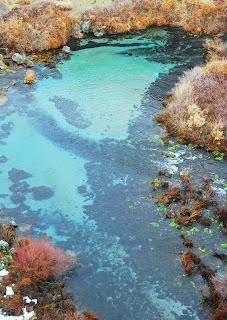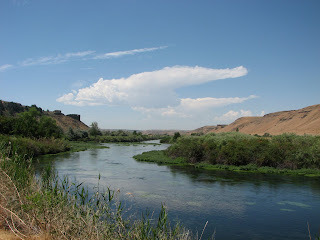- Nov 29, 2008
- 25,786
- 11,295
- 940
Invasive Species Prevention in Idaho's waterways has been a growing problem for years. That and the pollution caused by fish farms along the river.
My children grew up in this beautiful area. This first picture is a place where we used to float on inner tubes in the summer. It is directly across the river from my parents home. On the warm spring days one can see the huge Carp in the inlets while roaming the creek from the exiting springs on the canyon side that winds around Rickers Island until it reaches the river. We were floating through there one year and a little duckling had just hatched as we were all getting out of the boat. I had a little toy peke that went everywhere I went. The dog was the first thing the little duckling saw. I've got some pictures somewhere packed where the little guy was following the dog and the dog was looking at me like what do I do with this thing.
The green you see under the water is Watercress. It is edible. Growing up in the mountains of Southern California my horse used to eat this stuff every time we'd ride near a creek. I had to try it out one day to see what it was he enjoyed so much. It is kind of spicy hot like horse radish.

Locals call this Blue Heart it is about a mile up stream from the folks place. The water is ice cold. We'd only swim there on very hot days. The white shells bubble from the natural springs that come from underneath. We could sit there in the boat for hours watching the formations in the shells that look like a heart. As you can see from this picture the dark areas of growth under the water..these are invasive water plants. There is a special little snail that grows there. The white sandy bottom is from these left over shells that they leave behind. Proper name is Box Canyon.


Billingsley creek runs through an area of swamp grasses. The water was so clear there when the children were young you could see the bottom of the creek for miles as you floated along the winding creek to the pickup place. Over a period of fifteen years the pollution was so heavy you could no longer see the sand, fish and mussels in the creek bed. It has been about ten years since the nearby land owners sold their land and fish farms surrounding Billingsley Creek to the state so they could preserve this beautiful area.


These types of programs would much better serve conservation than what our US legislators are trying to push off on everyone so a few can make money off of all.
My children grew up in this beautiful area. This first picture is a place where we used to float on inner tubes in the summer. It is directly across the river from my parents home. On the warm spring days one can see the huge Carp in the inlets while roaming the creek from the exiting springs on the canyon side that winds around Rickers Island until it reaches the river. We were floating through there one year and a little duckling had just hatched as we were all getting out of the boat. I had a little toy peke that went everywhere I went. The dog was the first thing the little duckling saw. I've got some pictures somewhere packed where the little guy was following the dog and the dog was looking at me like what do I do with this thing.
The green you see under the water is Watercress. It is edible. Growing up in the mountains of Southern California my horse used to eat this stuff every time we'd ride near a creek. I had to try it out one day to see what it was he enjoyed so much. It is kind of spicy hot like horse radish.

Locals call this Blue Heart it is about a mile up stream from the folks place. The water is ice cold. We'd only swim there on very hot days. The white shells bubble from the natural springs that come from underneath. We could sit there in the boat for hours watching the formations in the shells that look like a heart. As you can see from this picture the dark areas of growth under the water..these are invasive water plants. There is a special little snail that grows there. The white sandy bottom is from these left over shells that they leave behind. Proper name is Box Canyon.


Billingsley creek runs through an area of swamp grasses. The water was so clear there when the children were young you could see the bottom of the creek for miles as you floated along the winding creek to the pickup place. Over a period of fifteen years the pollution was so heavy you could no longer see the sand, fish and mussels in the creek bed. It has been about ten years since the nearby land owners sold their land and fish farms surrounding Billingsley Creek to the state so they could preserve this beautiful area.

These types of programs would much better serve conservation than what our US legislators are trying to push off on everyone so a few can make money off of all.
The Idaho Invasive Species Fund
Recently passed legislation will assist in funding programs to prevent the introduction of invasive aquatic species in Idaho. The new law requires boaters, both motorized vessels and non, to contribute to the Idaho Invasive Species Fund (IISF). The Idaho Department of Agriculture is responsible for management of the IISF program.
New Law
Under the new law, any boat that is registered in Idaho or another state, and any non-motorized vessel (canoe, kayak, raft, drift boat, etc.) will be required to purchase and display IISF stickers in order to legally launch and operate in Idaho. Inflatable, non-motorized vessels must be less than 10 feet in length to be exempted from this requirement.
This sticker and fee will be in addition to any annual boat registration fees already being paid.
Fees
IISF sticker prices are $10 for motorized vessels registered in Idaho, $20 for other motorized vessels, and $5 per non-motorized vessel. Discounts for non-motorized commercial fleets are available. Stickers can be purchased online, by mail or at any Idaho State Park.
The fees generated from the sale of IISF stickers will fund vessel inspections, washing stations and informational materials that will assist Idaho with preventing the introduction of aquatic invasive species like quagga mussels. See the Invasive Species Fund FAQ for additional information.
Questions
IISF program-related questions should be directed to the Idaho Department of Agriculture.
